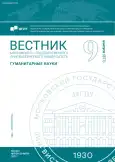Actualization of the THREAT Concept Semantic Content (based on directed associative experiment)
- Authors: Komalova L.R.1,2
-
Affiliations:
- Institute of Scientific Information for Social Sciences of the Russian Academy of Sciences
- Moscow State Linguistic University
- Issue: No 9(877) (2023)
- Pages: 25-34
- Section: Linguistics
- URL: https://journal-vniispk.ru/2542-2197/article/view/333347
- ID: 333347
Cite item
Full Text
Abstract
The paper explores verbal associations within the framework of the field approach. It focuses on a study of a set of words related in their meanings. The application of the directed associative experiment in research design made it possible to identify the structure and content of representations of threat concept. Based on 9 stimulus phrases we obtained 678 verbal reactions given by 61 subject. An analysis of those reactions for each of the stimuli presented made it possible to identify structural trends in the threat concept.
About the authors
Liliya Ryashitovna Komalova
Institute of Scientific Information for Social Sciences of the Russian Academy of Sciences; Moscow State Linguistic University
Author for correspondence.
Email: komalova@inion.ru
Doctor of Philology (Dr. habil.), Associate Professor, Head and Leading Research Fellow of the Centre of Emerging Practices, Institute of Scientific Information for Social Sciences of the Russian Academy of Sciences; Professor at the Department of Applied and Experimental Linguistics, Moscow State Linguistic University
Russian FederationReferences
- Shchur, G. S. (1974). Teoriya polya v lingvistike = Theory of field in Linguistics. Moscow: Nauka. (In Russ.)
- Shafikov, S. G. (1999). Teoriya semanticheskogo polya i komponentnoj semantiki ego edinits = Theory of semantic field and components semantics of its units. Ufa: Bashkir State University. (In Russ.)
- Kobozeva, I. M. (2000). Lingvisticheskaya semantika = Linguistic Semantics. Moscow: Editorial URSS. (In Russ.)
- Popova, Z. D., Sternin, I. A. (2007). Kognitivnaya lingvistika = Cognitive Linguistics. Moscow: AST-Vostok-Zapad. (In Russ.)
- Brinev, K. I. (2009). Teoreticheskaja lingvistika i sudebnaja lingvisticheskaja jekspertiza = Theoretical Linguistics and Forensic Linguistic Expertise. Barnaul: AltGPA. (In Russ.)
- Osadchiy, M. A. (2012). Parametrizations of verbal threat in Forensic Linguistics aspect. Modern Problems of Science and Education. Surgey. https://science-education.ru/ru/article/view?id=7633. (In Russ.)
- Galyashina, E. I. (2018). Judicial linguistic expertise and limits of use of linguistic science methods. Vestnik Moskovskogo universiteta MVD Rossii, 4, 31–36. (In Russ.)
- Baranov, A. N. (2021). Ugroza v kriminal’nom diskurse (semantika i pragmatika) = Threat in criminal discourse (semantics and pragmatics). Moscow: Azbukovnik. (In Russ.)
- Leontiev, A. A. (1997). Osnovy psiholingvistiki = Basics of Psycholinguistics. Moscow: Smysl. (In Russ.)
- Pishchalnikova, V. A. (2019). Interpretation of Associative Data as a Methodogical Issue of Psycholinguistics. Russian Journal of Linguistics, 23(3), 749–761. (In Russ.)
- Kashtanova, E. E. (1997). Lingvokulturologicheskie osnovaniya russkogo kontsepta lyubov (aspektny analiz) = Linguistic and cultural basis of Russian concept of love (aspect analisys): PhD in Philology. Ekaterinburg. (In Russ.)
- Pishchalnikova, V. A. (2007). Istoriya i teoriya psiholingvistiki: kurs lektsiy = History and theory of psycholinguistics: a course of lectures. Part 2: Ethnopsycholinguistics. Moscow: MSLU. (In Russ.)
- Kuznetsova, L. E. (2020). K voprosu o mekhanizme assotsiirovaniya v yazykovom soznanii individa = On the mechanism of association in the consciousness of the individual. Semiya i lichnost: problemy vzaimodejstviya, 17, 61–66.
- Starostina, E. V. (2016). Faktory, vliyayushchie na assotsiativnoe povedenie ispytuemykh = Factors influencing associative behavior of subjects. Russkaya Ustnaya Rech, 2, 104–112. Saratov: Amirit. (In Russ.)
- Vinogradova, O. E., Sternin, I. A. (2016). Psikholingvisticheskie metody v opisanii semantiki slova = Psycholinguistic methods in words semantics description. Voronezh: Istoki. (In Russ.)
- Jarceva, V. N. (ed.). (1990). Lingvistichesky entsiklopedichesky slovar = Linguistic encyclopedic dictionary. Moscow: Sovetskyaya entsiklopediya. (In Russ.)
- Komalova, L. R., Kalyuzhnaya, L. V. (2022). Broadening the ontology of threats verbalized in written communication on the Internet. Russian Journal of Linguistics, 26(3), 779–806. https://doi.org/10.22363/2687‐0088‐29939. (In Russ.)
Supplementary files










